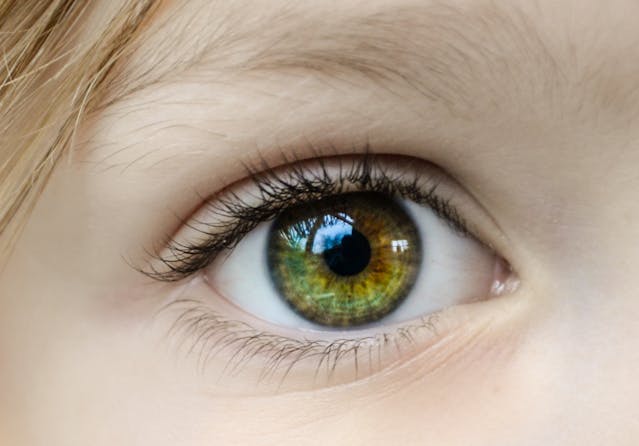
How many different eye colors do people have? There are only 6 different eye colors. They are amber, blue, brown, gray, green, and hazel.
There are many different colored eyes in the animal kingdom, but humans are far more limited in eye color than we think. Out of the six colors, brown is the most common. About 60% of the world’s population have brown eyes. The next most common are blue, hazel, and amber, which are about 10% each. Then about 2% of the people in the world have green eyes and less than 1% have gray eyes. These percentages are based on the global population because eye color can vary by country. Some countries have far more green eyes and some countries have far more brown eyes, for example. In the US, 9% of people have green eyes and 60% of the population of Norway have blue eyes.
So, what causes eye color? The color of the eyes is created by the pigments that our bodies produce. These pigments give us all the colors that we have, from our hair color to our skin color, and even the moles and freckles we have. The pigment is called melanin, and it is produced by melanocyte cells. They can make two kinds of pigment. They make eumelanin, which is a brown-black color, and they make pheomelanin, which is an orange-red color. The colors of our eyes is dictated by how much of these pigments we can produce. An eye that has more eumelanin will be a very dark color, and an eye that has less eumelanin and more pheomelanin would be a hazel color. The color pigment is in the iris of the eye, which is the part of the eye that contains the muscles that can widen or narrow the pupil to alter the amount of light that gets in. There are two layers to the iris, the back layer and the front layer. The back layer always has eumelanin, the dark pigment, in it. The front layer can have different quantities of either pigment, or none at all. It is this combination of pigments that gives all of the eye colors.
In that case, how can we have blue eyes? It is not possible to make blue by mixing both of these pigments and there is no pigment in our bodies that can make a blue color. The color blue is almost never found in nature because nothing can produce it. Many of the things we think are blue, such as blueberries, are not actually blue. There is a butterfly that is able to make blue, called the Obrina Olivewing butterfly, but we can’t do it. We get blue eyes by not having any pigment in the front layer of the iris. There is brown pigment in the back layer, but the front layer only has the white collagen strands of the muscle and no pigment. These strands of fiber scatter the light and reflect the blue light, making the eyes look blue. Green eyes are similar. The back layer has dark brown pigment, and the front layer has a light brown or orange pigment, which scatters the blue light, reflecting a green color. Albino people sometimes have pink eyes, but this is not caused by a pigment, rather it is caused by a lack of any pigment. Albinos don’t produce melanin and so their eyes have no color. That means there is nothing to reflect the light going through the iris and it hits the red blood vessels and capillaries at the back of the eye, giving the eye a pink color.
Why do we have eye colors? We have evolved coloring in our eyes to protect us from sunlight. Melanin in our bodies reflects light, protecting us. That is why we suntan when we are outside in the sun for a long time. The skin releases more melanin as a form of protection. The coloring in the eye does the same thing. Light hits the eye and either passes through the pupil or is reflected away or absorbed by the iris. A darker colored eye acts almost like sunglasses and dissipates more sunlight than a lighter colored eye would, protecting the pupil and the sensitive parts of the eye. There are more people with dark colored eyes the nearer you get to the equator because there is more direct sunlight and there are more people with blue eyes the further north or south you go because there is less direct sunlight. People have moved all over the world, so it’s not quite as simple as that now, but that is the reason why we have different eye colors. And that is what I learned today.
Photo by Skitterphoto: https://www.pexels.com/photo/closeup-photo-of-human-eye-862122/
Sources
https://www.livescience.com/56000-why-people-dont-have-orange-golden-eyes.html
https://www.verywellhealth.com/what-is-the-rarest-eye-color-5087302
https://my.clevelandclinic.org/health/articles/21576-eye-colors
https://www.medicalnewstoday.com/articles/319767#Pigment-makes-eyes-look-dark
https://www.aao.org/eye-health/tips-prevention/your-blue-eyes-arent-really-blue
https://www.vsp.com/eyewear-wellness/ask-eye-doctor/eye-color-and-vision
